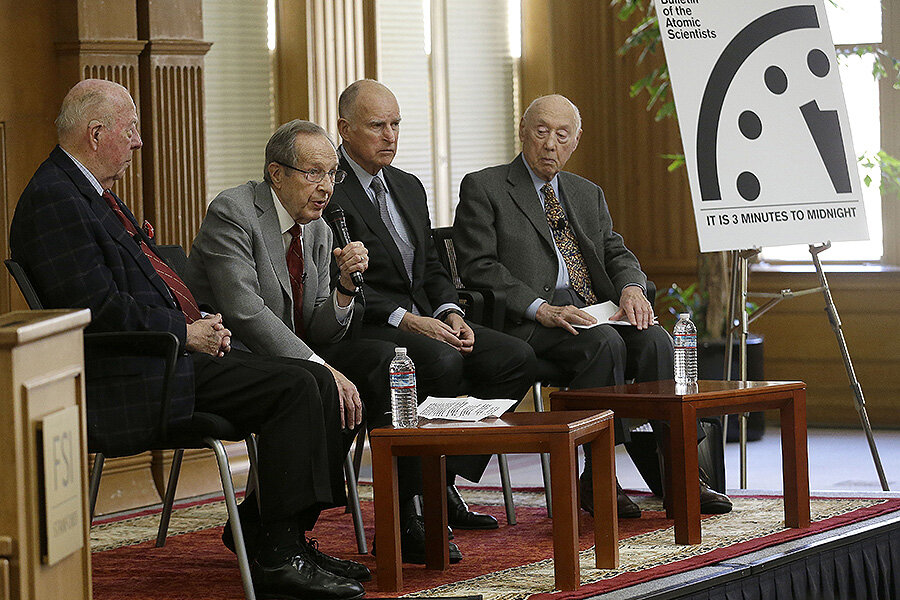Why the 'Doomsday Clock' says, we're still 3 minutes from midnight
Loading...
"It is still three minutes to midnight," the Bulletin of the Atomic Scientists wrote this week, announcing an update to its famous Doomsday Clock, whose estimate of the risk of global catastrophe has been ticking back and forth since 1947.
The time has not changed since 2015, however, when the Bulletin's Science and Security Board last moved the minute hand, from 11:55 to 11:57. As the Bulletin's somber, sometimes scathing public letter makes clear, that is not cause for celebration.
While the board applauds important steps to protect against the existential threats of nuclear war and climate change, such as the Iran nuclear deal and Paris Climate Conference, it also says that a pattern of one step-forward, one step-backward developments leaves the world "far too close" to disaster. The last time the clock read 11:57 was 1949, when the editor learned of the Soviet atomic bomb tests.
"The Iran nuclear agreement and the Paris climate accord are major diplomatic achievements, but they constitute only small bright spots in a darker world situation full of potential for catastrophe," the board writes. Cooperation with the Paris climate accord is unenforceable and, even with full compliance, insufficient in the long-term, they say, while countries' nuclear disarmament rhetoric is belied by new funds to "modernize" atomic weaponry. While the nuclear criticism focuses on the United States and Russia, the Bulletin also worries about developments in countries like China and North Korea, as well as instability in Syria and the South China Sea.
The Bulletin criticizes the Republican Party in the United States specifically for its "continued intransigence" on environmental policies; the party "stands alone in the world in failing to acknowledge even that human-caused climate change is a problem," they write, saying that for world leaders the "first order of business" should be preventing further danger from atomic weapons and global warming.
Not everyone is eager to heed the warning, however, including those who question the Bulletin's authority on political matters, or the seemingly arbitrary "minute" metric it uses.
Although many scientists on the Bulletin's board are experts in nuclear physics and environmental change, including 16 Nobel laureates, some say they're not qualified to assess the globe's political climate. And the clock's starting point, 1947's seven minutes to midnight, was chosen because it "looked good" to artist Martyl Langsdorf, the wife of Manhattan Project physicist Alexander Langsdorf.
Since then, it's been moved 22 times, from an all-time optimistic 11:43 at the signing of the Strategic Arms Reduction Treaty, to an all-time pessimistic 11:58 in 1953, when the US and the Soviet Union each tested hydrogen bombs. In 2007, the Bulletin expanded criteria to include non-nuclear threats, namely climate change and unregulated scientific testing.
"Whenever Doomsday Clock time rolls around, I roll my eyes, because the Clock doesn't actually gauge anything measurable," Michael D. Lemonick wrote in Scientific American:
The various threats the Clock concerns itself with – nuclear war and climate change are the biggies – have completely different timescales. If Vladimir Putin got up on the wrong side of the bed tomorrow, we could in principle have a devastating nuclear war within a few hours. Even in the worst-case scenario, by contrast, it will take a century or more for climate change to melt the Greenland ice sheet and drive sea level up by 20 feet.... It's more truthiness than truth. What the clock really measures is worry....
But pop-culture cachet, at the very least, makes the clock hard to ignore. And the Bulletin is putting its hope in global citizens, whom it asks to pressure their leaders towards peaceful and environmentally minded policies: finding solutions for nuclear waste, demanding Paris conference follow-up, and reduced spending for nuclear weapons, for instance. The Board also calls for better regulation of scientific experiments.
"Twentieth-century, business-as-usual approaches will not help us deal with these global challenges," Bulletin Board chair Professor Lawrence M. Krauss writes for the New Yorker. "As Albert Einstein said, after the first nuclear weapon was used in war, 'Everything has changed, save the way we think.' Unless we change the way we think, humanity remains in serious danger."








